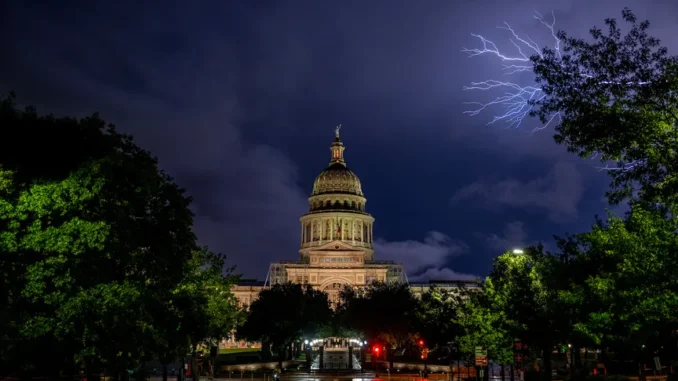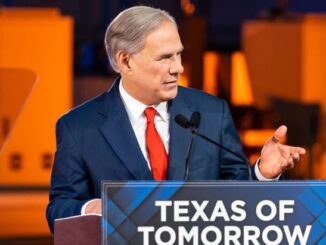
The best thing that Doug Lewin, president of Texas-based energy consultancy Stoic Energy, can say about the just-concluded Texas legislative session is that it could have been much, much worse.
Lawmakers failed to pass bills that would have helped stabilize and clean up the Texas grid, but at least they also, at the last minute, avoided passing bills that would have crushed the state’s clean energy industry.
The legislators should have been trying to enact laws to help prevent grid failures like the one that occurred in 2021, when a winter blackout left millions without power for up to a week, costing billions of dollars and resulting in hundreds of deaths, Lewin said. They also largely missed opportunities to improve energy efficiency and provide incentives for backup power and grid flexibility.
The Republicans in control of the state Capitol ignored the root causes of the state’s grid instability — a fossil-gas delivery network that remains vulnerable to extreme cold and heat waves, and a dearth of programs that would help energy consumers reduce the power they use to limit strains on the grid.
Instead, the legislators spent the session arguing over bills that would make renewable energy harder to build and provide multi-billion-dollar payouts to companies to construct new gas-fired power plants.
“There is an irrational animus toward renewables, a fundamental misunderstanding of what is causing the problems on the grid and what could be done to improve the situation,” Lewin said in a Tuesday interview. “We’re not even talking about the right things. All the debates at the end were about how much we’re going to screw over renewables, rather than what we’re going to do to fix these problems.”
But the most expensive and counterproductive policies, among the many threatening to undermine clean energy and drive up consumer costs, failed to be passed into law, Lewin said.
That’s because a “remarkable coalition of environmentalists, industry organizations and business groups” — including more than 50 chambers of commerce and trade groups representing manufacturers and even the oil and gas industry — united to defeat the worst measures, Lewin wrote in a post-session roundup for his Texas Energy and Power Newsletter. Together, these unusual bedfellows were able to stop a slew of policies that multiple analyses warned could increase costs to Texas energy consumers by billions of dollars per year without any evidence that they would improve grid reliability.
“I think it would be premature to make any grand conclusions about what that might mean going forward,” Lewin told Canary Media. “But there are reasons for optimism that there will be some increase in rationalism.”
Up until the final hours of this year’s frantic 20-week session, this outcome was still in doubt. Most of the bills promoted in the Texas Senate that clean-energy and consumer groups were especially concerned about were turned back in the state House of Representatives.
But four days before the end of the legislative session, many of these policies were reinserted as Senate amendments to HB 1500, a bill that had to be passed to reauthorize the authority of the Public Utility Commission of Texas and state grid operator ERCOT.
Those amendments threatened to increase the cost of electricity for Texas consumers by as much as $10 billion per year, according to IdeaSmiths, an analysis firm co-founded by University of Texas at Austin research scientist Joshua Rhodes. That would mean an increase of 50 percent over today’s costs, which have already risen significantly since the February 2021 grid disaster.
Over the final days of the session, a reconciliation committee working to align the Senate and House versions of HB 1500 managed to get rid of many of the most potentially harmful amendments.
“The big victory was avoiding these disasters for renewable energy. That was a big focus for us during this session,” said Matthew Boms, executive director of the Texas Advanced Energy Business Alliance, the state chapter of the Advanced Energy United trade group representing big energy consumers. “If it wasn’t for a few Republican champions in the House, you’d be reporting on the disaster that wasn’t averted.”
Down-to-the-wire decisions on costly market reforms
One early victory for backers of clean energy and grid reliability was the defeat of SB 6, a Senate bill that would have forced the state to finance the buildout of a fleet of gas-fired generators at an estimated cost of between $10.8 billion and $18 billion to be borne by taxpayers or electricity consumers. That bill ran into stiff opposition in the House of Representatives and was not included in the last-minute amendment push.
In lieu of this proposal, Senate leaders shifted their focus to SB 7, a bill that would order state grid operator ERCOT to create new market programs. One key point of contention was the Performance Credit Mechanism, or PCM, which would pay gas-fired generators more money for being available during grid emergencies. This would be a significant departure from the structure of Texas’s unique energy-only market, which unlike every other U.S. wholesale energy market relies solely on spikes in energy prices to encourage power plant owners to invest in building new capacity.
Texas regulators and lawmakers have been sparring for months over the scope of the PCM, which was first laid out by the PUCT in January. One big problem is that nobody knows just how the PCM and other market programs would function, since the PUCT deferred key aspects to ERCOT to be worked out in the years to come.
This lack of specificity has made the cost of the PCM to Texas power consumers unclear — and hotly contested. An analysis by E3, a consulting firm hired by the PUCT, put the price tag at $500 million per year. But opponents — including the Texas Oil & Gas Association, AARP Texas, Texas Consumer Association, Texas Association of Manufacturers, Texas chapter of the Sierra Club, and Texas office of the Environmental Defense Fund — highlighted other data that found the costs could range from $5.7 billion to $12 billion per year.
SB 7 passed, but as part of the maneuverings around it, the House was able to set a $1 billion annual cap on the costs of the PCM in an effort to limit the potential harm to consumers.
PCM wasn’t the only market program with unclear benefits and potentially burdensome costs that Texas lawmakers grappled with. One amendment to HB 1500 would have ordered ERCOT to create a market program, called Dispatchable Reliability Reserve Service (DRRS), that would assign costs not just on Texas power consumers as is done today, but on different types of generators.
Because the costs assessed to generators would be based on their “contribution to net load variability,” the policy as originally proposed would have forced wind and solar power, which vary in their output, to bear far higher charges than power plants that run on a regular basis, according to analysis from think tank R Street Institute. They could also increase consumer electricity costs by at least $4 billion per year, according to analysis from IdeaSmiths.
A version of the amendment passed, but negotiations in reconciliation committee in the final hours of the session did yield some important changes to the legal mandate for ERCOT to pursue the creation of these new market programs, Lewin said.
Those changes add significant analytical, monitoring and reporting requirements to keep costs in check and make sure that the new programs actually improve grid reliability, he said. Negotiators were also able to remove the requirement that generators pay a portion of the costs of the PCM, and deferred any such assessment of DRRS costs to generators pending a study to be completed in 2026. Their efforts reduced the risk of clean energy developers being saddled with new costs that could undercut their competitiveness against fossil fuels.
These complex market programs will take years of work at ERCOT and PUCT before they could be put into place, Lewin noted. That means that their impact on grid reliability, whether negative or positive, remains hypothetical.
Turning back attacks on renewables
The slew of policies aimed at restricting development of clean energy, by contrast, could have had an immediate negative impact, critics warned. That’s because adding increasingly low-cost clean energy in Texas has been vital to keeping electricity prices in check.
An October 2022 analysis by IdeaSmiths found that clean energy reduced wholesale electricity prices by nearly $28 billion from 2010 to 2022, with the vast majority of those cost savings coming in the past three years.
That’s why business and industry groups joined environmentalists and clean energy groups in fighting a welter of anti-renewable policies that ended up being defeated or significantly weakened by the end of the session.
Many of the anti-renewable proposals were put forward by the Texas Public Policy Foundation, a conservative think tank that has heavily promoted the disproven narrative that the state’s 2021 winter grid collapse was caused by the failure of clean energy resources. After being blocked in the House, many of these proposals were reinserted as amendments to HB 1500, and then stripped or watered down in the final reconciliation bill that emerged on Monday.
One amendment that Boms said would have been “really disastrous for renewable energy in Texas” would have imposed new permitting restrictions on private property owners seeking to build renewable power projects on their land — restrictions that don’t apply to fossil-fuel and nuclear power plants.
IdeaSmiths forecasted that these requirements, which would have required the creation of an entirely new regulatory structure within the PUCT, could have led to new clean energy development falling by 75 percent over the next three years, increasing wholesale electricity prices by $500 million to $1 billion over that time. That amendment was stripped from the final version of the bill that emerged from reconciliation.
Another amendment would have created a so-called “firming requirement” for all wind and solar projects, making them pay for other energy sources to be available during the times they are not producing — i.e., when the wind isn’t blowing and the sun isn’t shining — at a cost that had yet to be studied.
In reconciliation committee, House negotiators pushed any implementation of this firming requirement to the end of 2027 and significantly reduced the potential cost increases that could emerge by tying them to generation portfolios rather than individual generation units, Lewin said. “It will be interesting to see this play out over the next several years, and see if it’s even implementable,” he said.
One policy that could create roadblocks to renewable energy did end up being passed into law, Lewin noted. This policy directs the PUCT to set a “reasonable allowance” for the expense of interconnecting new generation resources to ERCOT’s transmission grid and requires generators to pay for costs that exceed that allowance.
ERCOT is one of the only grid operators in the country that doesn’t assign large interconnection costs to power projects, a factor that proponents say has allowed Texas to add new resources at a far faster clip than many other regions facing backlogs and delays. Depending on how this new interconnection allowance is administered, it “could add costs to renewables that get sited far away from transmission lines,” Lewin said, although just how it will be implemented remains an open question.
The Texas legislature only meets every other year, giving renewable boosters some breathing room before many of these defeated laws have another shot. But “you can bank on them coming back in the next session,” Boms said.
The missing link: the demand side
A problem with all of these market programs and anti-renewable measures, critics say, is that they stem from a false premise, oft-repeated by Texas Republicans, that the grid problems Texas faces stem from too much clean energy and not enough gas-fired power plants.
That means the programs and measures proposed by the state’s Republican leadership fail to address two key root causes of Texas’s unreliable grid, Lewin said. The first is the lack of regulations that would require gas power plants and the state’s gas industry to harden their systems against outages caused by cold snaps and heat waves. While some changes have been made since the February 2021 grid disaster to address these problems, far more remains to be done, he said.
The second cause of grid unreliability is a lack of policies to help Texas residents and businesses reduce how much energy they use, to lower the demand on the grid that has put energy suppliers under increasing strain. As the Sierra Club noted in a March blog post, “focusing only on the supply side of the equation is short-sighted, expensive, and ignores solutions that are quick, cheap and clean,” from building codes and energy-efficiency standards to distributed energy resources and demand response. These kinds of demand-side interventions could reduce grid strains at a much lower cost than directing money to new power plants, according to multiple studies.
Earlier this month, the American Council for an Energy-Efficient Economy released a paper showing that Texas could cut wintertime electricity demand by more than 16 gigawatts through incentives for energy-efficiency upgrades and heat-pump installations to replace inefficient electrical resistance heating, as well as smart thermostats and electric-vehicle charging controls to shift power use away from times of peak grid stress. The cost of these interventions would add up to about $100 million per year and save participating consumers about $6 for every $1 spent, ACEEE found.
Unfortunately, very little was accomplished on the demand side of this equation during the just-concluded legislative session, said Alison Silverstein, an energy analyst and former adviser to the PUCT and the Federal Energy Regulatory Commission.
“The most valuable and cost-effective way to improve the Texas grid is to start managing demand better with energy efficiency,” she said. But an energy-efficiency bill that would have required Texas utilities to achieve a 1 percent energy-savings target — one of the lowest such efficiency standards in the country — failed to pass the House and was rejected as an amendment to HB 1500.
Another bill that would have required the PUCT to set a goal for residential demand response also failed to pass in the House. “That was a great disappointment,” Silverstein said.
One potential bright spot for improving grid resiliency during extreme weather events did emerge from the legislative session, Lewin noted. But it was tied to a broader and more problematic measure that will have to pass muster with Texas voters this November.
That bill, SB 2627, would create a $10 billion state low-interest loan program to be made available to build new power plants. Late in the session, lawmakers introduced a carve-out of $1.8 billion to be made available for microgrids — combinations of fossil-gas generators, solar systems and/or batteries that can power critical facilities like hospitals and fire stations during power outages, as well as send power to the grid when it’s up and running.
Those microgrids could help not just the critical facilities they’re powering but broader swaths of the grid, by giving utilities and ERCOT more leeway to shift power outages between different grid circuits during emergencies like the February 2021 grid crisis, Lewin noted.
But the future of the entire loan program remains uncertain, he said. That’s because the creation of the loan fund will require an amendment to the state constitution, which needs to be approved by a majority of Texas voters in November’s general election.
Meanwhile, the only energy-efficiency-related bill that did pass will upgrade building codes for new buildings, but not address existing buildings, Silverstein said.
“We’re left with efficiency programs that are far, far more poorly funded than almost every other state in the nation, when our customers are facing extraordinarily high electric bills and extraordinarily high reliability challenges on the grid,” she said.



